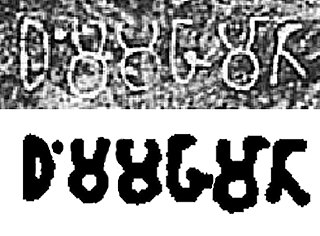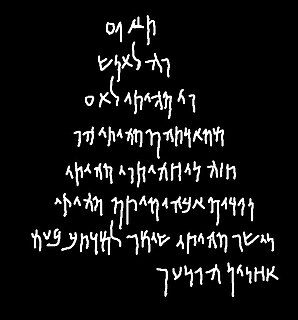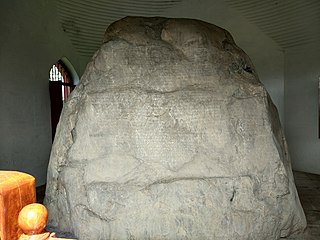
Ashoka, known by his Greek name Piodasses, also known as Ashoka the Great, was an Indian emperor of the Maurya Dynasty, who ruled almost all of the Indian subcontinent from c. 268 to 232 BCE. A grandson of the Maurya dynasty's founder Chandragupta Maurya, Ashoka promoted the spread of Buddhism across ancient Asia. Considered by many to be one of India's greatest emperors, Ashoka expanded Chandragupta's empire to reign over a realm stretching from present-day Afghanistan in the west to Bangladesh in the east. It covered the entire Indian subcontinent except for parts of present-day Tamil Nadu, Karnataka, and Kerala. The empire's capital was Pataliputra, with provincial capitals at Taxila and Ujjain.

The Edicts of Ashoka are a collection of more than thirty inscriptions on the pillars, as well as boulders and cave walls, attributed to Emperor Ashoka of the Mauryan Empire who reigned from 268 BCE to 232 BCE. Ashoka used the expression Dhaṃma Lipi to describe his own Edicts. These inscriptions were dispersed throughout the areas of modern-day Bangladesh, India, Nepal, Afghanistan and Pakistan, and provide the first tangible evidence of Buddhism. The edicts describe in detail Ashoka's view about dhamma, an earnest attempt to solve some of the problems that a complex society faced. According to the edicts, the extent of Buddhist proselytism during this period reached as far as the Mediterranean, and many Buddhist monuments were created.

The pillars of Ashoka are a series of monolithic columns dispersed throughout the Indian subcontinent, erected or at least inscribed with edicts by the Mauryan Emperor Ashoka during his reign from c. 268 to 232 BCE. Ashoka used the expression Dhaṃma thaṃbhā, i.e. "pillars of the Dharma" to describe his own pillars. These pillars constitute important monuments of the architecture of India, most of them exhibiting the characteristic Mauryan polish. Of the pillars erected by Ashoka, twenty still survive including those with inscriptions of his edicts. Only a few with animal capitals survive of which seven complete specimens are known. Two pillars were relocated by Firuz Shah Tughlaq to Delhi. Several pillars were relocated later by Mughal Empire rulers, the animal capitals being removed. Averaging between 12 and 15 m in height, and weighing up to 50 tons each, the pillars were dragged, sometimes hundreds of miles, to where they were erected.
The Kalinga War was fought in ancient India between the Maurya Empire under Ashoka and the state of Kalinga, an independent feudal kingdom located on the east coast, in the present-day state of Odisha and northern parts of Andhra Pradesh. It is presumed that the battle was fought on Dhauli hills in Dhauli which is situated on the banks of Daya River. The Kalinga War was one of the largest and deadliest battles in Indian history. Kalinga did not have a king as it was culturally run without one.

The Major Rock Edicts of Indian Emperor Ashoka refer to 14 separate major Edicts of Ashoka which are significantly detailed and represent some of the earliest dated rock inscriptions of any Indian monarch. These edicts are preceded chronologically by the Minor Rock Edicts.

Jaugada is a ruined fortress in the Ganjam district in Odisha, India. Jaugada lies 35 km north-west of Berhampur and 160 km south-west of Bhubaneshwar. Once a provincial Mauryan fortified capital of the newly conquered province of Kalinga, Jaugada is famed by its version of the monumental stone-cut edicts in Prakrit of the Mauryan emperor Ashoka.

Maski is a town and an archaeological site in the Raichur district of the state of Karnataka, India. It lies on the bank of the Maski river which is a tributary of the Tungabhadra. Maski derives its name from Mahasangha or Masangi. The site came into prominence with the discovery of a minor rock edict of Emperor Ashoka by C. Beadon in 1915. It was the first edict of Emperor Ashoka that contained the name Ashoka in it instead of the earlier edicts that referred him as Devanampiye piyadasi. This edict was important to conclude that many edicts found earlier in the Indian sub-continent in the name of Devanampiye piyadasi, all belonged to Emperor Ashoka. The edict is etched on a rock-face of Durgada-gudda, one of the gneissic outcrops that are present in the site.

The Ashokan edicts in Delhi are a series of edicts on the teachings of Buddha created by Ashoka, the Mauryan Emperor who ruled in the Indian subcontinent during the 3rd century BC. The Edicts of Ashoka were either carved on in-situ rocks or engraved on pillars erected throughout the empire; examples of both are found in Delhi.

Dhamma is a set of edicts that formed a policy of the Mauryan emperor Ashoka, who succeeded to the Mauryan throne in modern-day India around 269 C.E. He is considered as one of the greatest kings of ancient India for his policies of public welfare. His policy of Dhamma has been debated by intellectuals.

The Kandahar Bilingual Rock Inscription,, is a famous bilingual edict in Greek and Aramaic, proclaimed and carved in stone by the Indian Maurya Empire ruler Ashoka around 260 BCE. It is the very first known inscription of Ashoka, written in year 10 of his reign, preceding all other inscriptions, including his early Minor Rock Edicts, his Barabar caves inscriptions or his Major Rock Edicts. This first inscription was written in Classical Greek and Aramaic exclusively. It was discovered in 1958, during some excavation works below a 1m high layer of rubble, and is known as KAI 279.

The Kandahar Greek Edicts of Ashoka are among the Major Rock Edicts of the Indian Emperor Ashoka, which were written in the Greek language and Prakrit language. They were found in the ancient area of Old Kandahar in Kandahar in 1963. It is thought that Old Kandahar was founded in the 4th century BCE by Alexander the Great, who gave it the Ancient Greek name Αλεξάνδρεια Aραχωσίας.

The Minor Rock Edicts of Ashoka are rock inscriptions which form the earliest part of the Edicts of Ashoka, and predate Ashoka's Major Rock Edicts. These are the first edicts in the Indian language of Emperor Ashoka, written in the Brahmi script in the 11th year of his reign. They follow chronologically the Kandahar Bilingual Rock Inscription, in Greek and in Aramaic, written in the 10th year of his reign, which is the first known inscription of Ashoka.

The Major Pillar Edicts of Indian Emperor Ashoka refer to seven separate major Edicts of Ashoka inscribed on columns, the Pillars of Ashoka, which are significantly detailed and are among the earliest dated inscriptions of any Indian monarch. A full English translation of the Edicts was published by Romilla Thapar.

A Mahamatra was an "officer of morality" established by the Indian Emperor Ashoka. Their full title was Dhaṃma Mahāmātā, the "Inspectors of the Dharma". They were apparently a class of senior officials who were in charge various aspects of administration and justice.

The Minor Pillar Edicts of Indian Emperor Ashoka refer to 5 separate minor Edicts of Ashoka inscribed on columns, the Pillars of Ashoka, which are among the earliest dated inscriptions of any Indian monarch. A full English translation of the Edicts was published by Romilla Thapar.

The Pul-i-Darunteh Aramaic inscription, also called Aramaic inscription of Lampaka, is an inscription on a rock in the valley of Laghman, Afghanistan, written in Aramaic by the Indian emperor Ashoka around 260 BCE. It was discovered in 1932 at a place called Pul-i-Darunteh. Since Aramaic was the official language of the Achaemenid Empire, which disappeared in 320 BCE with the conquests of Alexander the Great, it seems that this inscription was addressed directly to the populations of this ancient empire still present in northwestern India, or to border populations for whom Aramaic remained the language of use.

The Aramaic inscription of Kandahar is an inscription on a fragment of a block of limestone discovered in the ruins of Old Kandahar, Afghanistan in 1963, and published in 1966 by André Dupont-Sommer. It was discovered practically at the same time as the Greek Edicts of Ashoka, which suggests that the two inscriptions were more or less conjoined. The inscription was written in Aramaic, probably by the Indian emperor Ashoka about 260 BCE. Since Aramaic was the official language of the Achaemenid Empire, which disappeared in 320 BCE with the conquests of Alexander the Great, it seems that this inscription was addressed directly to the populations of this ancient empire still present in northwestern India, or to border populations for whom Aramaic remained the language of use.

The Rock edicts of Khalsi, also spelled Kalsi, are a group of an Indian rock inscriptions written by the Indian Emperor Ashoka around 250 BCE. They contains some of the most important of the Edicts of Ashoka. The inscription in Khalsi contains all the Major Rock Edicts, from 1 to 14. They were discovered in Khalsi, a village in Uttarakhand, northern India, by Alexander Cunningham about 1850.

Bairat Temple is a freestanding Buddhist temple, a Chaityagriha, located about a mile southwest of the city Bairat, Rajasthan, India, on a hill locally called "Bijak-ki-Pahari". The temple is of a circular type, formed of a central stupa surrounded by a circular colonnade and an enclosing wall. It was built during the time of Ashoka in the 3rd century BCE, and near it were found two of Ashoka's Minor Rock Edicts, the Bairat and the Calcutta-Bairat Minor Rock Edicts. The temple is an important marker of the architecture of India.























